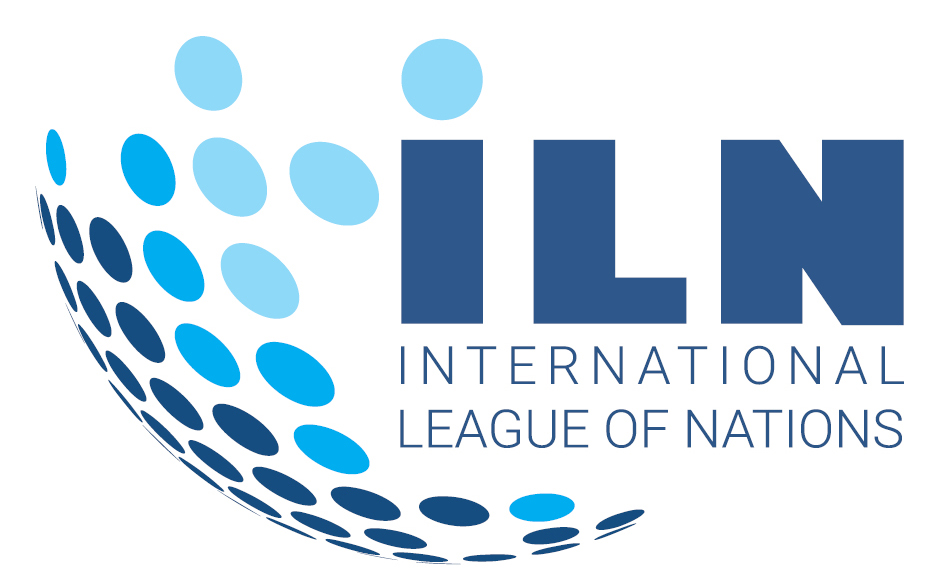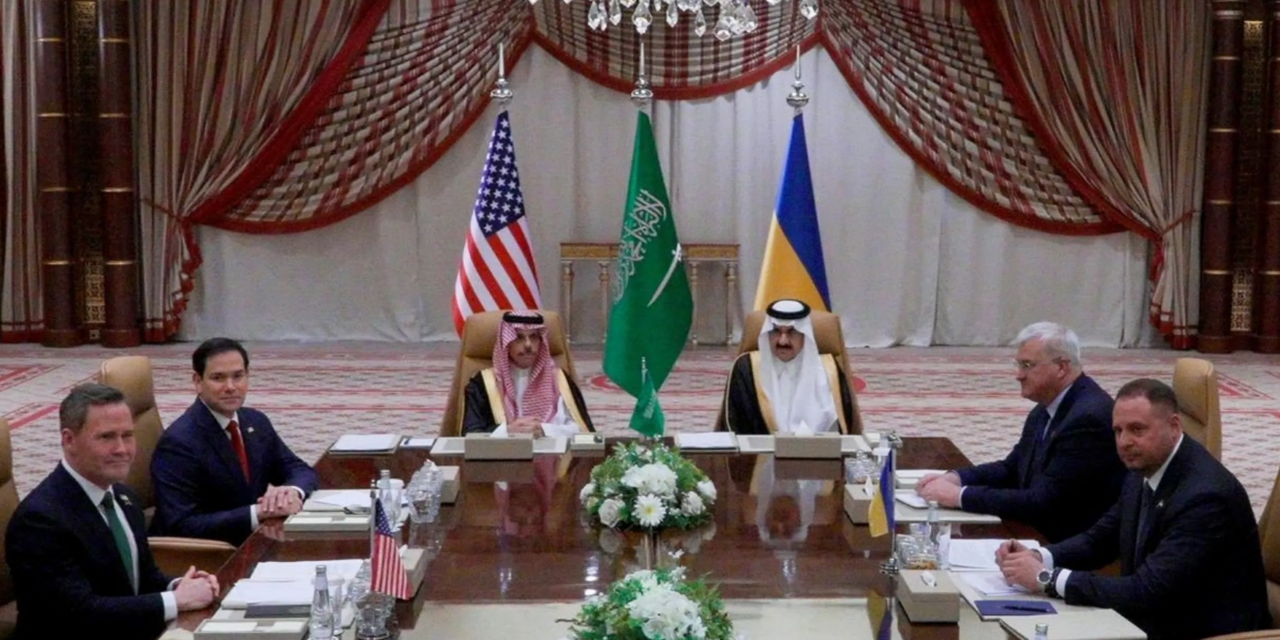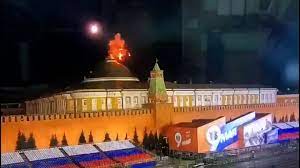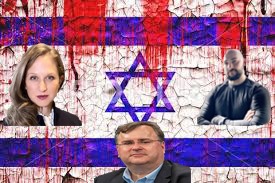In a significant diplomatic development, Ukraine has agreed to a U.S.-proposed 30-day full ceasefire with Russia, following negotiations held in Saudi Arabia on March 10, 2025.
This sudden shift has reignited debates over Ukraine’s military struggles, Russia’s long-standing demands, and the real intentions behind this proposal.
Yet, the ceasefire offer has been met with scepticism on multiple fronts—not only from Moscow but also from those questioning Western motives.
The European Union (EU), after months of insisting it would support Ukraine “for as long as it takes,” has suddenly signalled support for negotiations. This dramatic shift has left many wondering whether this is a genuine attempt at peace, or another strategic manoeuvre designed to serve Western interests at Ukraine’s expense.
Meanwhile, the United States has resumed weapons shipments and intelligence-sharing with Ukraine, contradicting the very idea of de-escalation.
Adding to the intrigue, Ukraine launched a massive drone attack on Moscow on the same day ceasefire talks were taking place.
This raises questions about whether Kyiv is genuinely seeking peace or merely setting a trap similar to the Minsk agreements of 2014 and 2015—a move designed to stall for time, rearm, and prolong the war indefinitely.
To understand what is happening behind the scenes we need to examine the specifics of Ukraine’s ceasefire proposal, contrasts it with past failed negotiations, explores Russia’s response, and analyses the broader strategic implications.
It also questions whether the ceasefire is a genuine attempt at peace or merely another Western geopolitical ploy, particularly in light of the false narrative about Ukraine’s Rare Earth Element (REE) reserves—a narrative that conveniently benefits Donald Trump and the U.S.
US-Ukraine’s Ceasefire Proposal: What’s on the Table?
According to official statements, the US-brokered Ukraine ceasefire proposal focuses on a 30-day full ceasefire, which would involve a temporary halt to all hostilities on both sides. However, the timing and sudden shift in rhetoric from Western leaders suggest there may be more at play than just a push for peace.
Key Terms of the Ceasefire Proposal
The US team proposed calls for an immediate freeze on:
- All military operations across the frontlines, including ground battles, artillery fire, and defensive or offensive manoeuvres.
- Airstrikes carried out by both Ukraine and Russia, including the use of fighter jets, attack helicopters, and drones.
- Naval engagements, preventing both sides from using military force in the Black Sea and the Sea of Azov.
- Long-range drone and missile strikes, meaning Ukraine would cease attacks on Russian cities, energy infrastructure, and military bases, while Russia would stop its strikes on Ukraine’s power grid, defence production sites, and military depots.
- Cross-border operations, meaning Ukraine’s recent drone and sabotage attacks inside Russian territory (such as those targeting Belgorod, Kursk, and Crimea) would be halted, as would any Russian cross-border incursions.
- Military activity in occupied territories, freezing the situation in Zaporozhye, Kherson, Donetsk, Luhansk, and Crimea without a clear roadmap for resolution.
Beyond military operations, the ceasefire proposal also includes demands from the Ukrainian team:
- Prisoner exchanges – A structured exchange of prisoners of war from both sides, with potential oversight from the International Red Cross or other neutral organizations.
- Return of Ukrainian children – Ukraine has repeatedly accused Russia of “forcibly relocating” children from occupied territories, while Russia claims these are evacuations for safety.
- Humanitarian corridors – Safe routes for the evacuation of civilians from active combat zones, ensuring food, medicine, and aid reach affected populations.
- Ceasefire extension – If successful, the 30-day agreement could be extended to allow for more in-depth negotiations on territorial disputes, security guarantees, and long-term conflict resolution.
On the surface, this proposal appears to be a logical step toward de-escalation. However, its timing and sudden announcement—immediately after European leaders were calling on Ukraine to “fight on”—raises serious doubts about the true motives behind the deal.
One of the most controversial aspects of the ceasefire proposal is the return of Ukrainian children who have been taken to Russia from war zones. This issue has been at the centre of international legal battles, war crime allegations, and heavy propaganda efforts.
While Ukraine and its Western allies accuse Russia of forcibly deporting children, Russia insists it has simply evacuated them to safety from war-torn regions such as Donetsk, Luhansk, Zaporizhzhia, and Kherson.
On the surface, the ceasefire proposal’s mechanism for repatriating these children might seem like a humanitarian gesture. However, for Russia—and particularly for President Vladimir Putin—this aspect of the deal carries serious risks.
In March 2023, the International Criminal Court (ICC) issued an arrest warrant for President Putin and Russia’s Presidential Commissioner for Children’s Rights, Maria Lvova-Belova, alleging the “forcible deportation” of Ukrainian children.
While Russia does not recognize the ICC’s jurisdiction, the arrest warrant was a major escalation in Western attempts to demonize Putin on the international stage.
If Russia agrees to the return of these children, it risks:
- Validating the ICC’s claims that these children were indeed taken unlawfully, which could be used to further pressure other nations into enforcing the arrest warrant.
- Weakening Russia’s legal and political position, as it would essentially be admitting to an action it has long denied.
- Allowing Ukraine to control the narrative, portraying the handover as a victory for “justice” rather than a diplomatic negotiation.
For Putin, this would be a major reputational risk both internationally and domestically.
Furthermore, if Russia agrees to this part of the proposal, Ukraine and its Western allies will almost certainly use it for massive PR and propaganda gains. The West could spin the event as:
- “Russia’s first step toward accountability” for alleged war crimes.
- A sign that Russia is weakening under international pressure.
- A narrative shift suggesting that other Russian territorial or political concessions could follow.
This could embolden Ukraine to demand more concessions in future negotiations—potentially including prisoner swaps, territorial withdrawals, or limitations on Russian military actions.
For Russia, this means that even if the agreement is reached in good faith, the optics could severely damage its standing in the information war.
What Are Russia’s Options?
Given the serious nature of the allegations by the West, Russia has several possible responses:
- Reject the proposal outright, stating that the children were legally evacuated and that their return is non-negotiable. However, this would likely lead to more Western pressure and continued ICC action.
- Agree to a “selective” return process, where only some children—such as those whose families can be identified—are sent back. This would be a way to appear cooperative without making major concessions.
- Demand a reciprocal gesture, such as an agreement that Ukraine will stop targeting Russian civilians in cross-border strikes.
- Frame the deal as a humanitarian act by Russia, rather than a concession, to prevent Ukraine from controlling the narrative.
The EU’s Sudden U-Turn: A Pattern of Abandonment?
Just a week ago, European leaders were loudly declaring their unwavering support for Ukraine. Officials in Germany, France, and the UK insisted they would back Kiev “for as long as it takes,” with no talk of negotiations.
Yet, seemingly overnight, these same leaders are now urging Ukraine to accept a ceasefire.
This kind of abrupt reversal is not new in Western foreign policy. The EU and NATO have a long history of encouraging their allies to fight, only to abandon them when the cost becomes too high.
Examples from the Past:
- South Vietnam (1973-1975): The U.S. and its allies backed the South Vietnamese government with military aid and promises of support. However, after the Paris Peace Accords, they cut off assistance, leading to the rapid fall of Saigon.
- Georgia (2008): The West encouraged Georgia to challenge Russia over South Ossetia but did nothing when Moscow responded militarily.
- Afghanistan (2021): After two decades of Western support, the U.S. and its allies abruptly withdrew, leaving the Afghan government to collapse within weeks.
- Kurdish Forces (2019): The U.S. supported the Kurds in Syria against ISIS but later withdrew protection, allowing Turkey to attack them.
Ukraine now appears to be heading down the same path.
Just days ago, European leaders assured Zelensky that Western aid would continue indefinitely—now they are pushing him into negotiations. This suggests that behind closed doors, NATO leaders have already decided Ukraine cannot win.
Suspicious Drone Attacks on Moscow
Adding to the scepticism, Ukraine launched a massive drone strike on Moscow on March 11, the same day ceasefire talks were held in Saudi Arabia. This attack also coincided with the head of the OSCE visiting Moscow, further complicating negotiations.
Since the ceasefire explicitly includes limits on such attacks, why would Ukraine launch them on the day of negotiations? Was this:
- A deliberate provocation to push Russia into rejecting the ceasefire publicly?
- A staged event to frame Russia as the aggressor?
- A ploy to pressure the U.S. and EU into further arms commitments?
Whatever the case, it suggests that Ukraine is not acting in good faith.
Russia’s Position: Territorial Gains
Despite Ukraine’s ceasefire overtures, Moscow remains sceptical. Some Russian officials have reportedly rejected the proposal, arguing that it serves as a tactical pause to allow Ukraine and the West to regroup and rearm.
President Vladimir Putin has reiterated Russia’s key demands, which remain unchanged since 2022:
- Recognition of Russian sovereignty over annexed territories (Crimea, Parts of Donetsk, Parts of Luhansk) Later amended to include all of Donetsk, all of Luhansk, Zaporizhzhia, and Kherson).
- Neutrality for Ukraine, ensuring never joins NATO.
- Demilitarization of Ukraine, particularly in regions bordering Russia.
- Legal protections for Russian-speaking populations in Ukraine.
Moscow views the ceasefire as a repeat of the failed Minsk agreements, designed to stall Russia’s advance while the West re-arms Ukraine.
Minsk I & II: A Trap Repeating Itself?
The current 30-day ceasefire proposal bears a striking resemblance to the Minsk agreements—both in its timing and its potential strategic implications. To fully understand why Russia remains sceptical of this new diplomatic initiative, it is essential to revisit what happened with Minsk I and Minsk II, how they were negotiated, and how they ultimately failed.
Minsk I (2014): A Short-Lived Agreement Meant to Buy Time for Ukraine
The first Minsk agreement was signed on September 5, 2014, in response to Ukraine’s military defeats in Donbass. After the US lead Euromaidan coup in early 2014, pro-Russian separatists in Donetsk and Luhansk declared independence, sparking a civil war. Ukraine launched a military operation to retake these regions but suffered heavy losses, particularly in battles such as Ilovaisk, where Ukrainian forces were surrounded and crushed by separatist militias.
With Ukrainian forces on the brink of collapse, Western leaders scrambled to broker a ceasefire. The result was the Minsk I Agreement, negotiated by the OSCE, Russia, Ukraine, and representatives of the breakaway republics (DPR and LPR) in Belarus. The key provisions included:
- Immediate ceasefire in Donetsk and Luhansk.
- Withdrawal of heavy weapons from the frontlines.
- Decentralization of power in Ukraine (giving Donetsk and Luhansk more autonomy).
- Special status for Donetsk and Luhansk, with local elections under Ukrainian law.
- Exchange of prisoners between Ukraine and separatist forces.
- Humanitarian aid access to the affected regions.
- Withdrawal of foreign fighters.
However, the agreement quickly fell apart. Ukraine refused to grant the people of the Donbass the autonomy it had promised, while both sides accused each other of ceasefire violations. By January 2015, heavy fighting had resumed, culminating in the devastating Battle of Debaltseve, where Ukrainian forces suffered another major defeat.
This led to the signing of Minsk II, a more detailed and complex agreement that was meant to permanently resolve the crisis.
Minsk II (2015): A Diplomatic Stalemate Used to Rebuild Ukraine’s Military
With Ukraine facing another military disaster, European leaders (particularly Angela Merkel of Germany and François Hollande of France) stepped in to broker Minsk II. This agreement, signed on February 12, 2015, included similar provisions to Minsk I but with more specific deadlines and monitoring mechanisms.
The key points of Minsk II were:
- Immediate ceasefire in Donbass.
- Withdrawal of heavy weapons within 14 days.
- OSCE monitoring of the ceasefire.
- Amnesty for combatants in Donetsk and Luhansk.
- Resumption of social and economic ties between Donbass and Ukraine.
- Constitutional reform in Ukraine, granting Donetsk and Luhansk “special status” (self-governance).
- Restoration of Ukrainian control over its borders, but only after autonomy was granted to the people of the Donbass.
At first glance, Minsk II appeared to be a viable path to peace. However, it quickly became clear that Ukraine had no intention of implementing it in good faith.
Eight years after it was signed and over 14,000 deaths including 1,500 children killed by Ukrainian Neo Nazis, Petro Poroshenko, Ukraine’s president at the time, admitted that Minsk II was never meant to be implemented—instead, it was designed to buy time for Ukraine to rebuild its army and prepare for a future conflict with Russia.
This was later confirmed by Angela Merkel and François Hollande, who both stated in interviews that Minsk II was not meant to resolve the conflict but to stall Russia while Ukraine strengthened its military with Western support.
Russia, which had agreed to the Minsk process under the assumption that it would grant the people of the Donbass autonomy and keep Ukraine out of NATO, felt betrayed. By 2021, with Ukraine actively discussing NATO membership and refusing to implement Minsk II, Russia saw no diplomatic path forward—leading to its military operation in February 2022.
Is This Ceasefire Just Another Minsk-Style Trap?
Given this history, Moscow has every reason to view the new ceasefire proposal with suspicion. The current situation shares key similarities with Minsk I & II:
- Ukraine is suffering battlefield defeats.
- The West is running out of weapons to send, much like it was in 2015.
- The EU is pushing for negotiations, just as Merkel and Hollande did before Minsk.
- A ceasefire would allow Ukraine time to rebuild its forces, similar to how Minsk was used to rearm the Ukrainian military from 2015 to 2022.
If this ceasefire follows the Minsk model, it will not lead to peace—it will simply be a temporary pause before another escalation.
Moscow’s likely response will be to demand guarantees that this is not just a diplomatic trick to buy Ukraine time. This could include:
- Western guarantees that Ukraine will not use the ceasefire to rearm (which is unlikely to be honoured and even harder to monitor).
- Neutrality for Ukraine, ensuring that it does not join NATO or receive long-range Western missiles. (Not likely at this early stage of negotiations.)
- Legal recognition of Russia’s territorial gains, ensuring that they are not up for negotiation. (This is a very likely possibility.)
If Russia’s territorial gains were legally recognized and taken off the table in future negotiations, it could shift the dynamics in several ways:
- Reduced uncertainty for both Russia and Ukraine – Both countries would be in a more secure position, not having to negotiate over these areas, allowing it to focus on other diplomatic or economic concessions rather than defending its territorial claims.
- Shifting Negotiation Focus – With borders settled, negotiations could pivot toward other important issues such as economic sanctions, security guarantees, prisoner exchanges, or future political relations between Russia and Ukraine.
- Stabilization of the Region – Legal recognition could reduce the likelihood of future military conflicts over these territories, potentially allowing for some degree of economic recovery and rebuilding in affected areas.
Without such assurances, Russia has little incentive to accept a ceasefire that only serves to delay the inevitable.
One of the biggest beneficiaries of this ceasefire proposal is Donald Trump, but not for the reasons his supporters might think.
For the last month, the U.S. media has aggressively pushed the idea that Ukraine will sign deals worth $500 billion for Rare Earth Elements (REE)—despite Ukraine not ranking in the top 25 REE-producing countries. While Ukraine does have some REE deposits and “Other things”, they are largely unexplored and underdeveloped, making the $500 billion figure wildly speculative at best. Yet, mainstream reports continue to promote the idea that Ukraine is set to become a REE powerhouse, feeding the narrative that Ukraine’s war effort is crucial to U.S. economic and strategic interests.
The entire REE narrative appears to be a manufactured PR campaign, designed to justify long-term U.S. economic control over Ukraine. This control is not just about military aid or NATO expansion—it’s about securing access to resources, infrastructure, and industry under the pretext of “making America great” by protecting its resources in Ukraine. The REE push conveniently aligns with Washington’s broader goal of pretending to reduce reliance on China, which currently dominates global REE production.
However, if Russia rejects a ceasefire, Trump’s team can pivot the narrative and reshape public opinion in ways that allows him to continue the war:
- Instead of the war being about “democracy,” it becomes about protecting U.S. resources in Ukraine.
In the past Biden’s administration framed the conflict as a battle between democracy and autocracy. But with a focus on rare earth mining deals, energy contracts, and post-war investment, Trump can shift the conversation from ideology to economic reliance. - Trump’s base, already sceptical of foreign wars, already view Biden’s Ukraine policy as a corrupt money grab for U.S. firms.
Many Trump supporters have long opposed U.S. military interventions, viewing them as costly and unnecessary. By changing the narrative Trump can focus on financial interests while blaming Biden’s democrats for a failed Ukraine policy, Trump can paint the Biden administration as warmongers serving elites who control the military industrial complex. This message would resonate with working-class voters, many of whom already feel abandoned by Washington’s foreign policy priorities. - Trump can position himself as the “America First” peace president.
By offering a ceasefire proposal—knowing it is likely to be rejected—Trump can claim that he tried to end the war but was ignored. This strengthens his anti-war stance, while also making Russia look like an aggressor. He’s aim will be to strengthen support for his non realistic ceasefire, while secretly giving the green light to the Military industrial complex, funding them ever increasing amounts of cash
The Bigger Picture: War as a Business Model
The rare earths narrative is just one example of how economic interests are embedded in Washington’s war strategy. U.S. defence contractors, energy companies, and mining firms all stand to profit from prolonged conflict and post-war reconstruction. Trump’s ability to expose this reality—while positioning himself as the anti-establishment outsider—could be a powerful political weapon. By getting the U.S. media suddenly shifts its messaging from “defending democracy” to “securing economic interests in Ukraine,” Trump can continue the military campaign silently enriching the same elites that he denounced.
Conclusion
Ukraine’s 30-day full ceasefire proposal raises serious doubts about its intentions. With the U.S. resuming arms shipments, the EU suddenly shifting its position, and suspicious drone strikes on Moscow, this may not be a step toward peace but a calculated move to keep Russia trapped in a never-ending conflict.
With the REE narrative conveniently playing into Trump’s favour, the question remains:
Is this ceasefire about peace—or just another trap to prolong the war indefinitely?






Hello! I hope you’re having a great day. Good luck 🙂